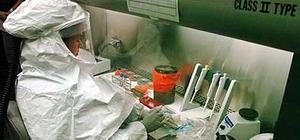BioterrorismBiolabs: the solution may be the problem
Since the fall 2001 anthrax attacks, there has been a vast expansion of the U.S. bioterror research infrastructure; now, more than 11,000 scientists work on bioterrorism and agroterrorism research in seventeen major and many more smaller labs across the United States; billions of federal dollars are funding research on new vaccines and antibiotics to protect the population from anthrax, plague, tularemia, Ebola, and other lethal germs; what is the likelihood that there is another Bruce Ivins — perhaps more than one — among these thousands of researchers with access to the most lethal pathogens on Earth?

Securing the pathogen stock is primary // Source: ljworld.com
Two events in fall 2001 – the attacks on the Twin Towers and mailing of the anthrax letters – led the Bush administration and Congress to expand the bioterror research capabilities of the United States. The expansion was massive. This is the infrastructure created in the wake of the anthrax letters:
- More than 11,000 scientists work on bioterrorism and agroterrorism research
- They are working in seventeen major and many more smaller labs across the United States
- These facilities are administered by federal agencies and at least a dozen universities
- Billions of federal dollars are funding research on new vaccines and antibiotics to protect the population from anthrax, plague, tularemia, Ebola, and other lethal germs
David Willman, a Pulitzer Prize-winning investigative reporter and the author of The Mirage Man: Bruce Ivins, the Anthrax Attacks, and America’s Rush to War, writes in the Washington Post that it may well be the case that the greatest risk of bioterror attack the United faces may come from within this vast infrastructure. Willman studied thousands of pages of the FBI investigation into the case of Bruce Ivins – the scientist accused of being behind the anthrax letters. He also interviewed many former and current scientists at the various high security biolabs. He writes:
I have been struck by the unwillingness of those responsible for the boom in biodefense research to address Ivins’s role and to publicly acknowledge the risks inherent in the labs’ proliferation. The vetting of scientists who are and will be handling anthrax and other deadly pathogens continues to fall far short of the strict controls for specialists who work in the Army’s nuclear or chemical warfare programs.
Willman offers details about Ivins’s mental instability and the fact that his erratic behavior was known to his fellow employees and supervisors. His mental state notwithstanding, Ivins had 24/7 access – unsupervised access — to his lab, where anthrax spores were stored. He was seeing a psychiatrist and was on atnidepressants.
Erratic behavior, psychiatric treatment, strong medications – these would have caused his removal from a nuclear plant or a chemical research facility. Yet, he was kept at the Army biolab. One reason was respect for privacy and reluctance of supervisors to be seen as discriminating against people with mental issues – especially if the individual is taking medications to control his problem.
Another reason, though, was the fear that removing a capable scientist from lab research because of his mental problem would put the whole lab – and its vetting process —in a bad light.
The Ivins problem is real. Willman writes:
Every lab manager I met also acknowledged privately his concern about the difficulty of detecting a skillful insider bent on disseminating a lethal biological agent. A rogue scientist could slip a test tube under a cuff or into a pocket undetected by video cameras, or evade psychological screenings. And if a lab worker knew he might lose his job at the first hint of instability, would he seek treatment for anxiety or depression?
With 10,000 thousand people working in labs in which research is done on the most lethal pathogens, what is the likelihood that there is another Ivins in a white coat in one of these labs?
